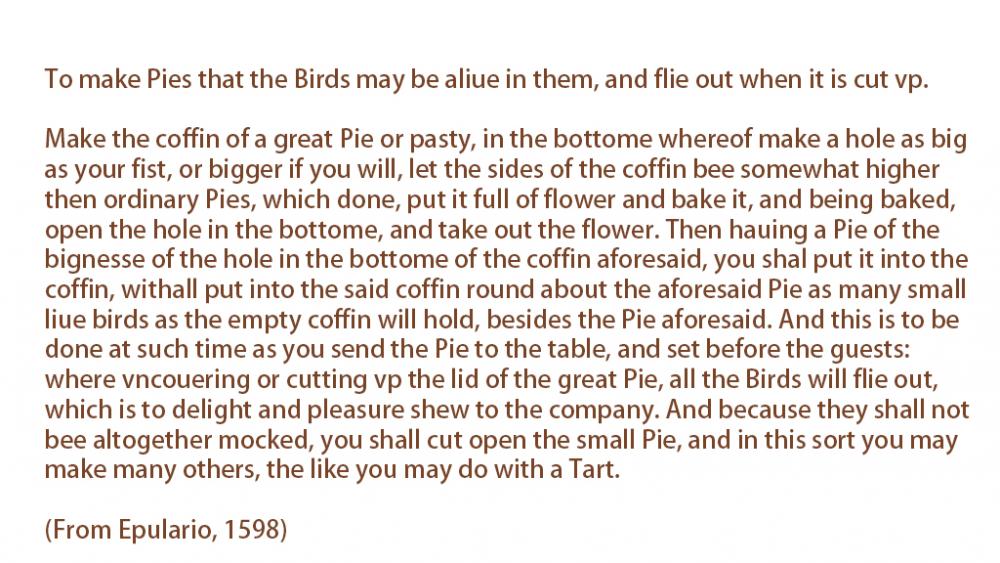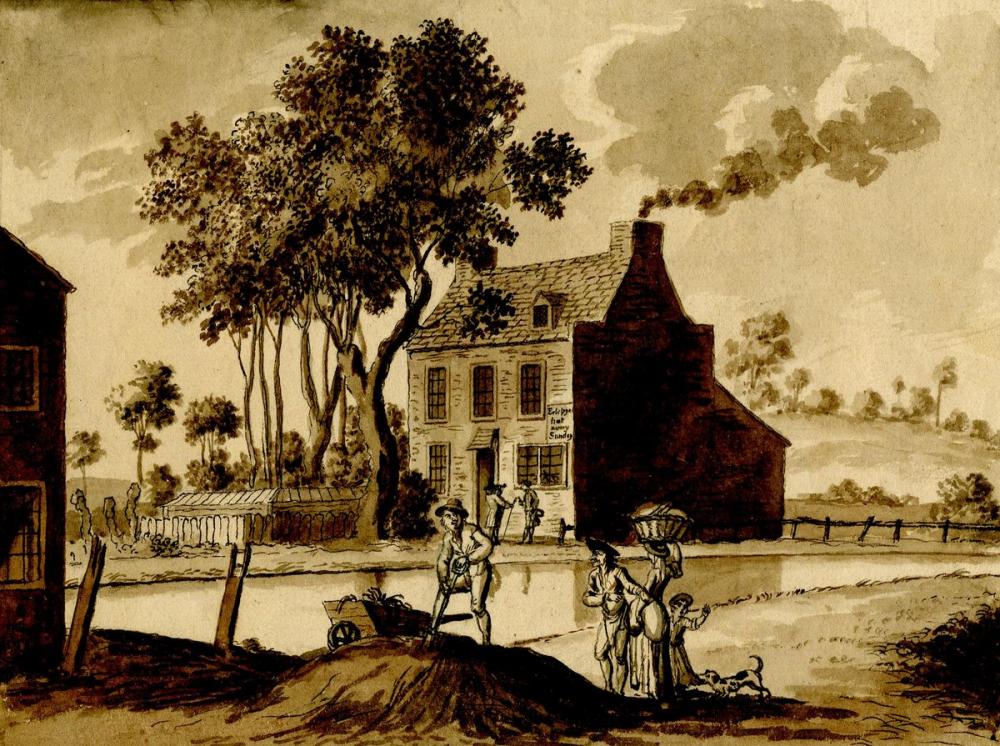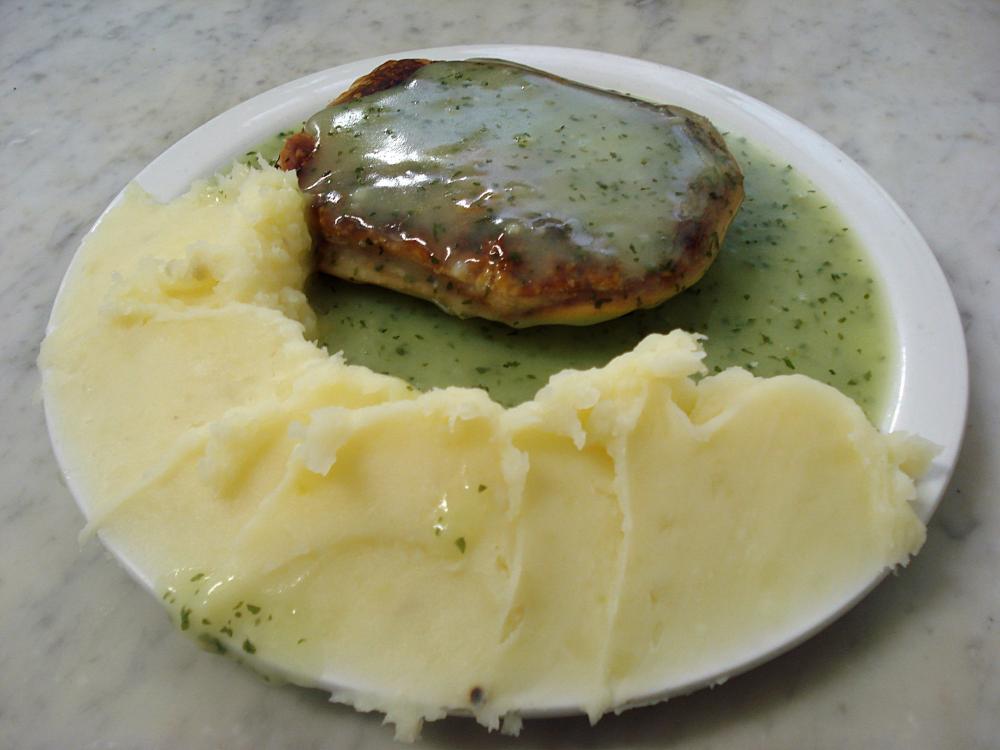6. π and Mash
Talking of mash leads me straight on to YouTube’s next top British food destination, to sample a “hugely popular dish” that the vast majority of British people have never eaten and which is becoming more and more rare. But first a bit of history.
Pies have been a British staple for centuries, probably introduced by the Romans who had learned the art of pie-making from the Greeks. One of the earliest known English language cookbooks “The Forme of Cury”, published around 1390, gives recipes for pies, including these “Crustardes of Flessh” meaning meat pies – in this case spiced pigeon, chicken and “small bird” pies. There are also recipes for pork pies and fish pies. Fruit pies didn’t appear for another 200 years, in the reign of Elizabeth I.

Note: “Cury” has nothing to do with the "Indian" dish, curry. ‘’Cury" is a Middle English version of “cookery” and could also refer to “cooked dishes”.
The Forme of Cury can be read online or downloaded as a free e-book in all popular formats, here.
By the 16th century, pies were popular with everyone from the poor agricultural workers who could carry them to the fields for lunch, all the way up to royalty who enjoyed ever more outlandish creations.
Sing a song of six-pence, a pocket full of rye
Four and twenty blackbirds, baked in a pie
When the pie was opened, the birds began to sing.
Now wasn’t that a tasty dish to set before the king!
This is not some bizarre fantasy, but a record of a real dish. Epulario, or The Italian banquet, an Italian cookbook by Giovanne De Rosselli, from 1598, gives a recipe.
An English translation of Upularia can be read online here or is available in paperback form on Amazon here (eG-friendly Amazon.com link).
In the mid to late 18th century, itinerant pie men wandered the streets of London and other major cities selling their beef, mutton or eel pies. They also visited fairs and other outdoor events. Not all their customers were called Simon or were simple.
Simple Simon met a pie man
Going to the fair;
Says Simple Simon to the pie man,
Let me taste your ware.
The origins of this rhyme are obscure, but it is generally dated to the 17th century.
At the peak of this pie trade, there were estimated to be some 600 pie men in London alone; but by the mid 19th century only around 50 remained and their time was soon to be up.
Throughout the 18th and particularly 19th centuries, more and more successful pie men started opening small shops to sell their pies. With permanent premises came better hygiene and consistency of products. The shops selling pies to be taken away soon also offered seating. Most were quite simple places, still catering to the working classes, but some were more upmarket, such as the one below.
Pie House, a popular tavern and tea garden in Harringay, north London, 18th century. Public Domain image.
Many of these pie shops in London also began serving stewed eels. Or eel shops also started selling pies. The River Thames was, at that time, a major source of European eels, providing another cheap but nutritious protein to supplement the pies. The eels were generally stewed and served hot until it was noticed that, if left to cool down, the cooking liquid turned to jelly, eels being high in collagen. So, the shops started selling both stewed eels and jellied eels.
Jellied eels. Image by JanesDaddy; licenced under CC BY-SA 3.0
By the end of the 19th century and early 20th century, pollution had emptied the Thames of eels and they had to be imported, mainly from Holland. This, of course, raised the price out of reach of the poorer classes.
In the 1960s, the river was cleaned up and, although eels did return, not in the quantities seen in the past. Meanwhile, overfishing elsewhere had severely endangered supplies. Although jellied eels are still available, they are no longer cheap and many conservationists etc. advise against eating them. They are normally served with either chili-infused vinegar or plain.
The oldest surviving pie, mash and eel shop in London today is Manze’s from 1902. Michele Manze (1875-1932) was a three-year-old when his family emigrated from Italy hoping to improve their lives. They first made a living selling ice cream then went on to making ice cream to be sold by others. In 1902, wishing to expand business and be independent, Michele, now in his 20s, shortly after marrying, opened a shop selling pies, like so many before him. That shop survived as do two others he opened (out of a total of five - the other two were bombed out in WWII). Michele’s brothers also opened similar shops and by 1930 there were 14 Manze shops in London. Most have now gone, but Michele’s original remains, now run by his great-grand-daughter.
Manze's Pie and Mash, 2008. I
mage by Kake ; licenced under Attribution-NonCommercial-ShareAlike 2.0 Generic (CC BY-NC-SA 2.0)
Today, the number of pie and eels shops is a fraction of what it was in the past. Nearly all are in east and south London. Their menus are usually small. Pie and mash, stewed or Jellied eels and that’s it!
So let’s look and pie and mash. This consists of an individual meat pie containing minced beef. The pie is made with two types of pastry. A cold-water suet pastry forms the shell containing the filling and the lid can be either a shortcrust pastry or rough puff pastry. It is served with mashed potatoes.
Manze's Pie and Mash with Liquor.
Image by Kake; licenced under Attribution-NonCommercial-ShareAlike 2.0 Generic (CC BY-NC-SA 2.0)
The pies are served with a thin parsley sauce, known as liquor. This does not mean it contains alcohol; “liquor” here is being used in one of its older meanings.
QuoteThe water in which meat has been boiled; broth, sauce
OED
The traditional recipe for the sauce used the water in which the eels were cooked, but this is rare now. The liquor is coloured bright green by the parsley, giving it what many describe as an odd appearance.
So the YouTubeing half-wits roll up to sample this delight. Judging by their faces, few enjoy it but they nearly all declare it to be wonderful!. It isn’t wonderful. It was never designed to be wonderful! It was poverty food, a cheap and simple way to fill yourself with something reasonably nutritious. But not bland. I have eaten it – once. It was OK, but I never went back.
Jellied eels don’t do it for me – I’m not a jelly fan. But the hot stewed type were pleasant. It is very noticeable that almost none of the YouTube brigade ever try the eels and I strongly suspect that has nothing to do with ecological concerns.







